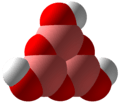Metaboric acid
Metaboric acid is the name for a family of inorganic compounds formed by the dehydration of boric acid. Metaboric acids are colourless solids with the empirical formula HBO2.[1] There are two forms of metaboric acid, all are white solids. One form of metaboric acid is molecular, and the other forms are polymers.
| |||
| Names | |||
|---|---|---|---|
| IUPAC name
Oxoborinic acid | |||
| Other names
Metaboric acid | |||
| Identifiers | |||
3D model (JSmol) |
|||
| ChemSpider | |||
| ECHA InfoCard | 100.033.313 | ||
| EC Number |
| ||
| 121829 | |||
PubChem CID |
|||
CompTox Dashboard (EPA) |
|||
| |||
| |||
| Properties | |||
| B3H3O6 | |||
| Molar mass | 131.45 g·mol−1 | ||
| Appearance | white solid | ||
| Density | 1.784 g cm−3 | ||
| Melting point | 176 °C (349 °F; 449 K) | ||
| Acidity (pKa) | 9.236 | ||
| Conjugate base | Metaborate | ||
| Structure | |||
| trigonal at B | |||
| Hazards | |||
EU classification (DSD) (outdated) |
|||
| R-phrases (outdated) | R36/37/38 | ||
| S-phrases (outdated) | S26, S37 | ||
Except where otherwise noted, data are given for materials in their standard state (at 25 °C [77 °F], 100 kPa). | |||
| Infobox references | |||
Preparation
Heating of boric acid at 80-100 °C releases water to give orthorhombic metaboric acid:[2] 3 B(OH)3 → (BOH)3O3 + 3 H2O
This form is molecular, consisting of discrete trimers. This molecule has C3h symmetry and forms a sheet-like structure, similar to that of boric acid itself. It is also called "modification III" of the metaboric acids.[2]
Upon heating at 130-140 °C in a sealed ampoule (to prevent dehydration), orthorhombic metaboric acid converts to the monoclinic form:
- (BOH)3O3 → B3O4(OH)(H2O)
This material, called modification II, has a polymeric structure, and a higher melting point (201 °C) and density (2.045 g/cm3). The structure of this species resembles its precursor except that the rings are connected and 1/3 of the boron centres are tetrahedral.[3]
 Conversion of orthorhombic to monoclinic metaboric acid.
Conversion of orthorhombic to monoclinic metaboric acid.
Above 140 °C, boric acid or the other forms of metaboric acid convert to cubic metaboric acid.[4]
Metaborates
Metaborates are derivatives of BO2−. Like metaboric acid, the metaborates exist with disparate structures. Examples are sodium and potassium metaborates, salts formed by deprotonation of orthorhombic metaboric acid containing the cyclic B3O63− ion and calcium metaborate, Ca(BO2)2, which contains the chain polymeric ion (BO2−)n.[1]
References
- Greenwood, N. N.; & Earnshaw, A. (1997). Chemistry of the Elements (2nd Edn.), Oxford:Butterworth-Heinemann. ISBN 0-7506-3365-4.
- H. J. Becher "Metaboric Acid" Handbook of Preparative Inorganic Chemistry, 2nd Ed. Edited by G. Brauer, Academic Press, 1963, NY. Vol. 1. p. 791.
- W. H. Zachariasen "The crystal structure of monoclinic metaboric acid" Acta Crystallogr. 1963, vol. 16, pp. 385-389. doi:10.1107/S0365110X6300102X
- Freyhardt, C. C.; Wiebcke, M.; Felsche, J. (2000). "The monoclinic and cubic phases of metaboric acid (precise redeterminations)". Acta Crystallogr C. 56 (3): 276–278. doi:10.1107/S0108270199016042. PMID 10777918.

